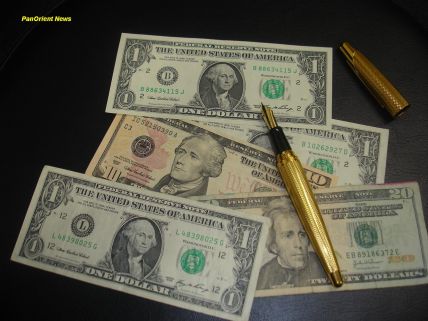|
|
Business
Time to Give Gold a Place in the Global Monetary System
Wednesday, December 22, 2010

By Anthony Rowley
PanOrient News- Tokyo- Had you been alive to buy lunch for two at London's famous Savoy Hotel a hundred years ago, you could have dined in some luxury for some five English shillings. Today, the same meal at the Savoy would cost nearer 50 pounds or 200 times as much. Yet, had you paid in gold in 1910 that same piece of gold would buy you an equal lunch today (except that gold is no longer legal tender).
The remarkable ability of gold to preserve its value in terms of paying for goods and services, as well as for measuring the price of other assets, is the chief reason why people from World Bank President Robert Zoellick to certain U.S. Congressmen, along with many others around the world, would like to see gold restored to some role in the global monetary system.
While the U.S. Dollar – the main currency used for conducting global transactions and for denominating foreign exchange reserves – has been devalued massively in recent decades (since it was unpegged from gold by former U.S. president Richard Nixon in 1971), gold has remained a constant measure and store of value, admittedly with some ups and downs along the way.
Gold – once the firm anchor of the international monetary system – has remained anchored in reality while paper currencies have floated on a tide of inflation toward their own destruction. The ratio of world debt to global GDP) jumped from 44% to just under 60% between 2007 and 2010 alone and is expected to reach 65% by 2015. In the U.S., financial debt had soared to five times the level of GDP at the outbreak of the financial crisis in 2008, compared with three times before the Great Depression.
Most people agree that the dollar has entered a long-term decline in terms of value and influence. But just how soon this will lead to its being toppled as the principal store of monetary value is the subject of much debate. China with its massive dollar-dominated reserves frets that a dollar collapse could happen quite soon, while people like Japan's “Mr. Yen” – Eisuke Sakakibara – think it will take another 20 years.
What has set people worrying most is Federal Reserve chairman Ben Bernanke's experiment with massive “quantitative easing,” which involves printing untold billions of dollars of new money and injecting it into the U.S. financial system, ostensibly to pull the world's largest economy out of the doldrums where it has been languishing since the global financial crisis struck in the autumn of 2008.
If all that money were to remain within the U.S., all well and good (except for inflation in the U.S.). But a widespread fear is that it will flow out of the U.S., where yields on investment are at an historic low, and into economically buoyant emerging economies where much more attractive returns are available, thus creating “asset bubbles” on a global scale.
Quantitative easing is adding substantially to the massive overhang of dollars outside the United States. If you count all the dollars in the Eurodollar and Asian-dollar banking markets and add them to other offshore holdings of U.S. dollars, the total comes to around $12 trillion or roughly the same size as U.S. GDP, notes Rei Masunaga, a former Bank of Japan official.
How much will QE add to this overhang? The Fed has already committed itself to nearly $1 trillion of new monetary injections, according to William Thomson, a former vice president of the Asian Development Bank and nowadays an investment guru. “What comes after is uncertain,” says Thomson.
But, he adds, “if Goldman Sachs is to be believed, the final amount of QE required could total over $4 trillion in coming years.”
Just what impact this massive resort to the money printing presses by Bernanke (known as “helicopter Ben” because of his fondness for throwing money at economic problems) will have on the value of an already devalued dollar is anybody's guess. But it's safe to assume it will weaken it further.
Already China has grown jittery about its large holdings of dollars. A year or so ago, People's Bank of China Governor Zhou Xiaochuan called for an alternative global reserve currency, a call backed by none other than former Fed chairman Paul Volcker, a giant among central bankers.
While Zhou favoured using the IMF's special fiat “currency” the SDR (Special Drawing Rights) as a basis for the new system, the World Bank's Zoellick thinks that gold should have some role to play in a reformed global monetary system.
Specifically, what he suggested was that the G-20 should work towards creating a new and cooperative monetary system based on the dollar, euro, yen, pound and (eventually) the renminbi. No-one got excited over the idea of a basket of reserve currencies, but when Mr. Zoellick said that “the system should also consider employing gold as an international reference point of market expectations about inflation, deflation and future currency values,” all hell broke loose.
Likewise, his suggestion that “although textbooks may view gold as the old money, markets are using gold as an alternative monetary asset today” was greeted with denials and cries of disdain. Critics argued against restoring any formal monetary role for gold, including those Washington academics who all gave the idea a thumbs down response. Their view was that Zoellick's arguments were quaint or even dangerous.
Gold is no inflation hedge, some argued. Its price has risen sevenfold in a decade while inflation has been tame, they said, while others noted that a reserve currency needs a supply that can grow as fast as world trade if it is not to constrain economic activity. The world should “not crucify itself on a cross of gold once more,” yet others claimed. Reversion to a gold standard would be “viciously deflationary.” Zoellick's claim that markets are using gold as an alternative monetary asset was also rejected.
Yet the claim that the surge in the gold price over the past decade is not related to any obvious inflation does not stand up. There have been repeated bouts of spectacular inflation in asset prices – housing and equities in particular. Likewise there are holes in the argument that a reserve currency needs to have a supply that keeps pace with increases in world trade (or output) if economic activity is not to suffer. But what if trade or output are fueled by an unsustainable expansion of credit, as was the case before the global financial crisis?
Markets are not using gold as alternative monetary asset because there is no evidence of “transactions being priced in ounces of gold,” Zoellick's detractors argued. But this is only because gold is not (yet) acceptable tender for everyday transactions. Meanwhile, gold’s mirror-image rise against the dollar and other currencies is proof that it is being viewed by investors as an alternative monetary asset.
The consensus among many professional investors, is that the price of gold will reach $2,000 an ounce within the coming year, and that the dollar may never regain pole position as the main global reserve currency. Instead, they say, there will be a need for a new, gold-linked reserve that will stand the test of time. If linking money supply ultimately to the availability of gold seems an unacceptably rigid notion, they add, how much less unacceptable is the idea of an infinite expansion of money at the whim of central banks that can create liquidity to cover past excesses or to inflate their way out of trouble.
Such arguments are beginning to influence certain influential members of the U.S. Congress who plan to submit a Bill that would require the U.S. to revert to some kind of gold standard. As Masunaga points out, however, “One of the big issues in starting the system could be how to settle the existing official dollar liabilities of the U.S. authorities, as they do not possess a sufficient amount of gold reserves.”
PanOrient News
© PanOrient News All Rights Reserved.
|
|

